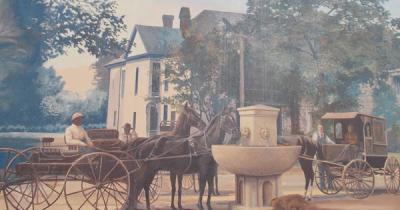
Carrying your own reusable water bottle around is the thing to do these days. Not only is it good for you, it’s good for the environment. Our nifty new water bottle refilling station at the library lets us know exactly how many plastic bottles have been saved because folks are filling their own bottles. Less than a month into its installation, and the counter tells us that we’ve helped eliminate waste from 2530 disposable plastic bottles.
And that’s at just this one station. Imagine how many bottles are being saved every year from fillers like this around the world.
But while this particular technology is relatively new, the concept behind it is not. Since becoming a town, Paducah has always looked for better, cleaner ways to deliver needed water to the public.
Of course, Paducah was founded because of water. The Ohio and Tennessee rivers not only provided industry and transportation, but a source of drinking water. Yet, even the early days, the riverfront at the foot of Broadway was not the best source for clean water. People used the river front for docking and launching boats, bathing, watering animals, and disposing of personal and commercial waste. So, despite the presence of a major, the city trustees looked to install a public well very early in Paducah’s history.
Paducah was platted in 1827, established as a town in 1830, and the first public well was constructed in 1833 on Broadway between First and Second streets across from the entrance to Maiden Alley. The well was a great convenience to the fledgling town and a boon for public health, yet it was not without controversy. The problem lie with the well bucket and the propensity for the citizenry to let it fall back down the well and break. With so many broken buckets, the trustees of Paducah passed an ordinance about a year after the well’s installation that made it illegal to let the bucket fall back down the well, carrying with it a fine of $4 per offense.
Drinking water wasn’t the only water-related concern in the early days of Paducah. Fire was also a big problem and with no piped-in water, a small blaze could quickly get out of control. Young Paducah experienced two major fires: one in 1835 that destroyed the Front Row buildings between Broadway and Jefferson, and one in 1851 that destroyed burned much of the southside of Paducah around Water Street, Market Street, and Kentucky Avenue. The answer to early firefighting was the strategic placement of large, in-ground water cisterns around town. Able to hold several thousand gallons of water, the cisterns were a quick source of water should a blaze break out. An article from a September 30, 1898 issue of the Paducah Daily Sun reported that the city’s oldest cistern had been filled in for becoming a safety hazard. That cistern, installed in 1850, was located in the vicinity of 128 N. 4th at the site of what was once an old city court room and calaboose (or holding cell). At the time it was filled in, the site was Paducah’s Central Fire Station.
Even as late as the early 1900’s, Paducah still maintained upwards of a dozen cisterns as insurance against fire. One, located in the middle of Broadway Street across from the entrance to the Market House held the equivalent of 500 barrels of water, or 15,750 gallons.
Of course, the public wells and cisterns are no longer around today. But one of Paducah’s watery firsts is still around…a public horse and dog drinking fountain.
The idea for a horse drinking fountain was first proposed for the city of Paducah by Frederick Tilghman, son of General Lloyd Tilghman, on September 18, 1907. Though born in Paducah, Frederick hadn’t visited the city since he was a boy, and was in town to make arrangements for an eight foot tall bronze statue of his father to be erected in Lang Park. Enamored of the city he’d left long ago, Tilghman proposed the procurement of a second monument: a drinking fountain that would provide clean water to horses, and dogs. It was an issue close to Tilghman’s heart for he also happened to be vice president of the National Humane Alliance in New York, a precursor to the Humane Society.
Because Tilghman offered to foot the $1000 bill, the city accepted the proposed fountain and decided to place it at the intersection of 10th and Broadway
Details of the fountain reached the Paducah Evening Sun on October 11 of that year. Under the headline “Humane Society Fountain Will Be Shipped At Once,” the article stated, “The fountain will be six feet, six inches high from the ground to the top. The large bowl for the use of horses will be six feet in diameter and carved from a single piece of granite. At the base will be four cups or basins to contain water for dogs.” One side of the fountain held a plaque in honor of the National Humane Alliance’s president, Herman Lee Ensign. The other three sides held large lion heads with streams of water flowing from their mouths into the bowl below.
The fountain was installed in 1908 but wasn’t hooked up to water lines until 1910. By that time, cars were beginning to overtake horses as the preferred mode of travel. Despite the fountain’s use becoming outdated nearly as soon as it was installed, it is still around today, a lasting reminder of Paducah’s water-filled history.